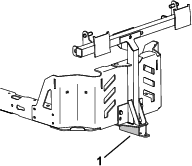Safety
-
Become familiar with the safe operation of the equipment, with the operator controls, and safety signs.
-
Use extra care with grass catchers or other attachments. These can change the operating characteristics and the stability of the machine.
-
Follow the manufacturer's recommendations for adding or removing wheel weights or counterweights to improve stability.
-
Do not use a grass catcher on steep slopes. A heavy grass catcher could cause loss of control or overturn the machine.
-
Slow down and use extra care on hillsides. Be sure to travel in the recommended direction on hillsides. Turf conditions can affect the stability of the machine. Use extreme caution while operating near drop-offs.
-
Keep all movement on slopes slow and gradual. Do not make sudden changes in speed, direction, or turning.
-
The grass catcher can obstruct the view to the rear. Use extra care when operating in reverse.
-
Use care when loading or unloading the machine into a trailer or truck.
-
Never operate with the discharge deflector raised, removed or altered, unless using a grass catcher.
-
Keep hands and feet away from moving parts. Do not make adjustments with the engine running.
-
Park the machine on level ground, disengage the drives, and shut off the engine before leaving the operator's position for any reason including emptying the grass catcher or unclogging the chute.
-
If you remove the grass catcher, be sure to install any discharge deflector or guard that might have been removed to install the grass catcher. Do not operate the mower without either the entire grass catcher or the grass deflector in place.
-
Do not leave grass in the grass catcher for extended periods of time.
-
Grass catcher components are subject to wear, damage and deterioration, which could expose you to moving parts or allow objects to be thrown. Frequently check components and replace with the manufacturer's recommended parts, when necessary.
Towing Safety
-
Do not attach towed equipment except at the hitch point.
-
Follow the attachment manufacturer's recommendation for weight limits for towed equipment and towing on slopes.
-
Never allow children or others in or on towed equipment.
-
On slopes, the weight of the towed equipment may cause loss of traction and loss of control. Reduce towed weight and slow down.
-
Stopping distance increases with the weight of the towed load. Travel slowly and allow extra distance to stop.
-
Make wide turns to keep the attachment clear of the machine.
-
Do not tow a load that weighs more than the towing machine.
Installation
Loose Parts
Parts needed for this procedure:
| Stabilizer bracket | 1 |
| Carriage bolt (5/16 x 3/4 inch) | 2 |
| Locknut (5/16 inch) | 4 |
| Self-tapping screw (5/16 x 3/4 inch) | 2 |
| Bolt (5/16 x 1 inch) | 2 |
| Pivot frame | 1 |
| Hairpin cotter | 2 |
| Rod | 2 |
| Washer | 2 |
-
Remove the existing 2 bolts, 2 nuts, and hitch bracket from the bottom of the engine guard (Figure 1).
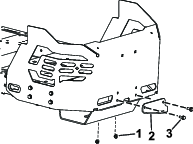
-
Install the stabilizer bracket to the engine guard using 2 carriage bolts (5/16 x 3/4 inch) and 2 locknuts (5/16 inch) as shown in Figure 3.
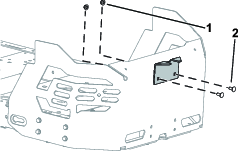
-
Remove the existing 2 self-tapping screws from the bottom of the machine frame (Figure 4).
-
Loosely install the pivot frame to the machine frame using 2 bolts (5/16 x 1 inch) and 2 locknuts (5/16 inch) as shown in Figure .
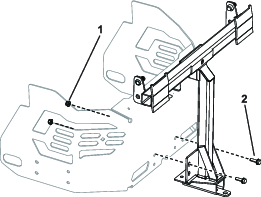
-
Position the pivot frame upward, and secure the pivot frame to the bottom of the machine frame using 2 self-tapping screws (5/16 x 3/4 inch) as shown in Figure 4.
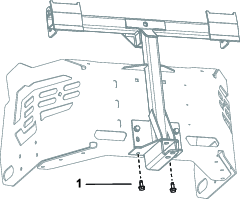
-
Tighten the 2 bolts (5/16 x 1 inch) and 2 locknuts (5/16 inch) as shown in Figure .
-
Install the bent, flared end of a rod into the keyed slot in the left side of the machine frame, and move the rod rearward to seat it in the frame (Figure 5).
Note: Repeat this step for the right side of the machine.
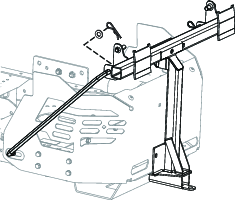
-
Insert the bent ends of the rods into the attachment mount as shown in Figure 5 and secure the end of each rod with a washer and hairpin cotter.
Operation
Note: Determine the left and right sides of the machine from the normal operating position.
Warning
To avoid personal injury, follow these procedures:
-
Become familiar with all operating and safety instructions in the Operator's Manual for the machine before using this attachment.
-
Always shut the engine off and wait for all moving parts to stop before clearing an obstruction from the bagging system.
-
Never do maintenance or repairs while the engine is running.
Using the Draw Bar
The attachment mount has a draw bar feature that you can use for towing.
-
Read and understand all the operating instructions of the machine.
-
When turning, slow down and observe the clearance.
-
Make wide turns and keep towed equipment clear of the towing vehicle.
-
The maximum draw bar pull is 36 kg (80 lb).
-
Excessive draw bar pull may cause hydrostatic transmission failure.
